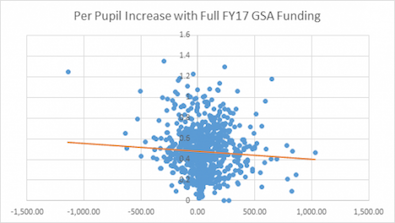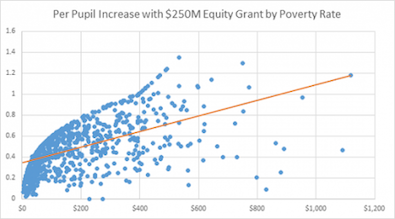

Latest Post | Last 10 Posts | Archives
Previous Post: What’s in the BIMP?
Next Post: Silver: Trump is gonna get trounced in Illinois
Posted in:
* Stand for Illinois Children takes a look at the new K-12 plan…
We got some snippets of information about the education bill that looks like it’s coming together and wanted to provide an update. (But keep in mind that we haven’t seen bill language for the formula changes and that none of this is a done deal until they pass it to the Governor’s desk and he signs it into law.) […]
First, the (as-yet-unseen) bill would give every school district the same amount as they received last year through the formula. Then, $250 million would be distributed through an Equity Grant, which would flow to districts based on their poverty concentration. Finally, every district would get at least what it would have received if the formula were fully funded next year, even if the first two pieces didn’t get them quite there. My math shows the total increased cost would be $328 million.
This isn’t a long-term solution to fix the deeply inequitable funding disparities in Illinois. Illinois’s school formula is one of the most regressive and unfair system in the country and we desperately need a comprehensive solution. But, without an education budget in place, the neediest students in the poorest districts will suffer the most. The Equity Grant proposal takes a step toward equity while giving the legislature time to come up with a new funding structure.
Below are two charts. The first shows where new dollars would be allocated if the current General State Aid (GSA) formula were fully funded. The second shows how the Equity Grant proposal increase is allocated. Funding the current GSA system results in a trendline that has no correlation to district need. The Equity Grant trend shows more dollars being delivered to schools with higher rates of poverty – exactly the direction that Illinois needs to move in.
The bill was released after the above was written. It’s an amendment to SB 2047.
* The two charts…


* More…
Want to know more details about what this means for your own school district? Here’s our best guess. Keep in mind we haven’t seen language and there are a few variables that could change. (In fact, one variable will definitely change – we need to revise this using net GSA numbers for last year instead of gross GSA. It’s not a huge difference, but we’ll dig that up ASAP and update this.) In general, lower-income districts across the state will see the biggest per pupil gains, from Antioch far up north (+$788 per pupil) to Anna-Jonesboro far down south (+$600) and from Brooklyn in the Metro East (+$650) to South Holland in the South suburbs (+$491). Chicago Public Schools has the 111th biggest per pupil gains (+$291).
posted by Rich Miller
Thursday, Jun 30, 16 @ 10:30 am
Sorry, comments are closed at this time.
Previous Post: What’s in the BIMP?
Next Post: Silver: Trump is gonna get trounced in Illinois
WordPress Mobile Edition available at alexking.org.
powered by WordPress.
There will be “inequality” as long as wealthy districts choose to overspend on K-12 education without receiving commensurate value.
The key issue is NOT inequality between moderately run schools and those whose communities are willing to bloat with tax dollars, but what funding is ADEQUATE for schools around the state. The Augenblick and Meyers methodology used by EFAB for “foundation level” is deeply flawed in that regard.
We need to engage in serious discussion about what we need in facility resources, and what levels of staff compensation are necessary, as well as distribution of that compensation, to encourage those most effective for our kids to stay in the system and improve it.
If we’re going to make “equality” a state issue rather than a local one, we need to do more than just shift resources around without clear goals and purpose.
Comment by Illinois Bob Thursday, Jun 30, 16 @ 10:48 am
Great start to seeing the data on this. Will be more interesting to see the per student poverty grant numbers when they are (if) finally released,
Rather than poverty being used as the main criteria for extra funding I would like to see more equal expenditure per student taking into account the tax effort (tax rate) of the school districts. But that is the political push being used any more so I have little hope for my standard.
Comment by Federalist Thursday, Jun 30, 16 @ 10:50 am
We need to engage in serious discussion about what we need in facility resources, and what levels of staff compensation are necessary, as well as distribution of that compensation, to encourage those most effective for our kids to stay in the system and improve it.
If we’re going to make “equality” a state issue rather than a local one, we need to do more than just shift resources around without clear goals and purpose.
Illinois Bob, you have mentioned some very legitimate concerns that should be addressed and are purposely being ignored. We may or may not agree on what those standards and solutions amount to.
Comment by Federalist Thursday, Jun 30, 16 @ 10:57 am
Could Republicans kindly explain why this increase in funding for CPS does not constitute a “bailout”?
Comment by anon Thursday, Jun 30, 16 @ 11:00 am
I think the takeaway is, for the second year in a row, that any claim by anyone that they’re willing to risk schools not opening is a obvious bluff.
It was a bluff when Rauner made all his GOP peeps vote against the K-12 bill (which he signed, and has called his greatest achievement).
And it was a bluff when Cullerton said he’d risk it to get a complete budget.
They’d all get burned if schools didn’t open; the “blame game” spin would save no one.
Comment by wordslinger Thursday, Jun 30, 16 @ 11:03 am
The whole issue of the value of “poverty grants” needs to be discussed in any funding reform debate.
Just handing out bucks to bureaucracy to pocket in anyway it wants is just exploiting the disadvantaged students.
Funding limited “summer programs” for challenged low income kids makes better sense. It’s been shown that about 10% of learning is lost over a too long summer break. Low income kids can’t afford that.
On line, self paced learning is another way to help low income kids through technology. Give them access to the self teaching mechanisms there, and give them credit for successfully completing the coursework. This ties in with technology grants. Don’t assume that low income kids are “stupid”. As US history has shown, “poor” kids often become the highest achievers when given the opportunity. I certainly noticed that as a teacher.
This is the SMART way to use resources to help low income kids. The problem is that “smart” is an adjective rarely justified in describing Springfield.
Comment by Illinois Bob Thursday, Jun 30, 16 @ 11:17 am
wow. This is awesome. Great job to the staff at Stand for Children. I think if you look at the stats and Chicago ranks 111th–one is pretty hard pressed to call it a bail out.
Comment by Tom Thursday, Jun 30, 16 @ 11:17 am
Kudos to Stand for Children for their rational, swift analysis made public.
Comment by Formerly Known As... Thursday, Jun 30, 16 @ 11:26 am
Anon — Could Republicans kindly explain why this increase in funding for CPS does not constitute a “bailout”? –
Read the analysis. CPS isn’t even in the top 100 districts receiving new per pupil funding. In other words, it’s not a Chicago bailout.
Comment by Shytown Thursday, Jun 30, 16 @ 11:35 am
I’m not a supporter of the current formula, but the graphs are a bit misleading. Poverty level isn’t the only thing driving state resources to schools under the current formula or proposals out there this year. Local wealth is a factor in everything, and doesn’t necessarily change proportionally with poverty levels.
Some districts don’t have the ability raise much in local resources. When you add money, you will drive resources to them as well.
Comment by m Thursday, Jun 30, 16 @ 11:53 am
They really need to look at need vs. simply poverty. Using a history of annual audits going back 3-5 years would help demonstrate that. Cicero 99 does not need any money. Lots of others do.
Comment by JS Mill Thursday, Jun 30, 16 @ 2:12 pm
== They really need to look at need vs. simply poverty. Using a history of annual audits going back 3-5 years would help demonstrate that. Cicero 99 does not need any money. Lots of others do. ==
Well, yes.
But that isn’t going to happen in the next 24 hours or even before school opens in August.
Do this deal, now, to stabilize the patient then let’s work on a long term cure.
Comment by Hamlet's Ghost Thursday, Jun 30, 16 @ 2:57 pm
10 of the top 12 school districts that have the highest per pupil gains have under 600 students. Two have 50 students or less.
Comment by Dance Band on the Titanic Thursday, Jun 30, 16 @ 4:22 pm
the numbers displayed in this post are not accurate.
Comment by the girl has no name Thursday, Jun 30, 16 @ 4:22 pm